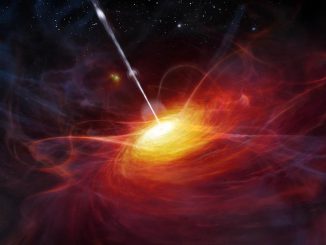
Spectroscopic measurements of gas dynamics at the core of the Milky Way have revealed several unusual objects visibly whizzing around the supermassive black hole at the center of the galaxy that have the appearance of gas clouds but act like stars.
Using an imaging spectrograph with at the W.M. Keck Observatory in Hawaii, researchers collected 12 years of observations, expecting to map out subtle changes in the shape and velocity of gas near the central black hole. To their surprise, they spotted several compact dusty objects.
Two of those, known as G1 and G2, were discovered more than 10 years ago. They were thought to be clouds of gas, but they somehow survived close flybys of the black hole.
“If they were gas clouds, G1 and G2 would not have been able to stay intact,” said Mark Morris, a co-principal investigator. “Our view of the G-objects is that they are bloated stars, stars that have become so large that the tidal forces exerted by the central black hole can pull matter off of their stellar atmospheres when the stars get close enough, but have a stellar core with enough mass to remain intact. The question is then, why are they so large?”
Morris and other researchers at UCLA’s Galactic Center Orbits Initiative believe the G-objects likely are the end result of stellar mergers triggered by the black hole’s enormous gravity.
“In the aftermath of such a merger, the resulting single object would be ‘puffed up,’ or distended, for a rather long period of time, perhaps a million years, before it settles down and appears like a normal-sized star,” Morris said.
Using a tool known as the OSIRIS-Volume Display, or OsrsVol, the team was able to analyse the spectra of G1, G2 and at least three other such objects to determine their sizes and track their motion relative to the black hole.
The long-range goal now is to track the newly discovered objects through their next close flybys of the hole to find out whether they survive the encounter.
“We’ll have to wait a few decades for this to happen, about 20 years for G3 and decades longer for G4 and G5,” Morris said. “In the meantime, we can learn more about these puffballs by following their dynamical evolution using OSIRIS.”
UCLA Postdoctoral Scholar Anna Ciurlo said understanding G objects “can teach us a lot about the galactic center’s fascinating and still mysterious environment. There are so many things going on that every localised process can help explain how this extreme, exotic environment works.”



